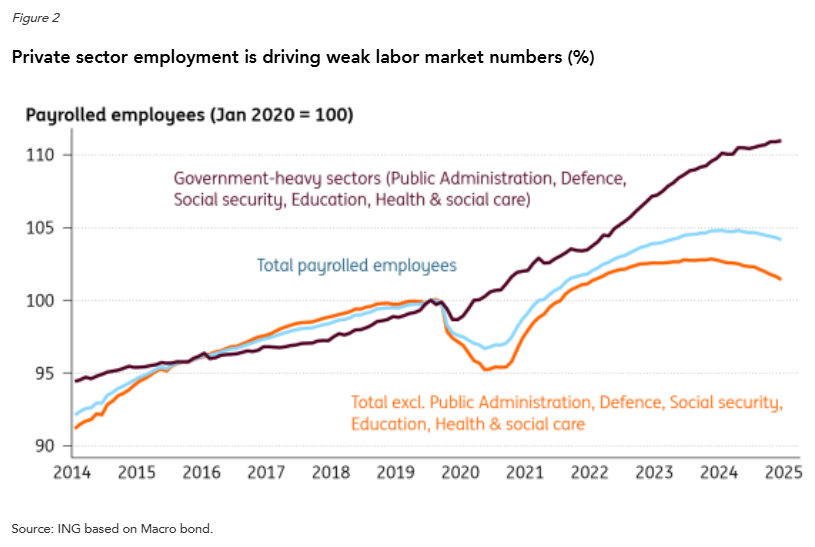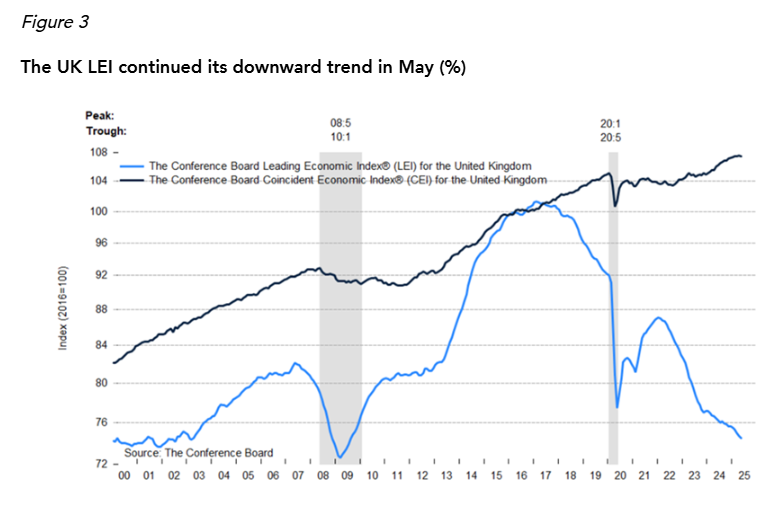A 25 basis points cut was all but certain
There was no suspense behind the Bank of England’s (BoE) decision to cut its monetary policy rate by 25 basis points. But the drivers and implications of this move suggest we are at an inflection point, with the BoE entering accommodative territory (Figure 1).

Labor market and inflation statistics pull in opposite directions
Weak labor market numbers warrant a looser monetary stance, but sticky inflation does not make the decision straightforward.
Labor market statistics are surrounded by uncertainty, but concerns are focused on particularly weak private sector numbers (Figure 2).

Source: ING based on Macrobond.
At the same time, current inflation readings are slightly above BoE’s expectations and remain uncomfortable for the Central Bank, creating some pause about a quick loosening of monetary policy. Headline inflation was at 3.6 percent year-on-year (y/y) in June 2025 (above the BoE's expectations of 3.4 percent) and it has been above the 2 percent target since September of last year. Services inflation in the UK has proven sticky (4.7 percent y/y in June) and should persist with many services prices being set annually, further driving high core inflation (3.7 percent y/y in June).
While dissent is more common—and less controversial—in the BoE that in other central banks, like the Fed, increased divergence since March show how uncertainty is weighing on policymaking. The May and July decisions were reached with four and three dissenting votes, respectively (out of a total nine total votes). In the August decision there were four dissenting votes (supporting holding the rate) and one member voting for a 50 basis points cut. On average, in 2025 there have been 2.8 votes dissenting from the majority decision, compared to 2.1 in 2024.
But broader economic weaknesses made the decision easier
Weak and deteriorating economic indicators beyond the labor market likely solidified the decision to cut. The latest Leading Economic Index (LEI) by The Conference Board shows worsening prospects for the UK, driven by low consumer and housing sales expectations, with comparable numbers to those during the Global Financial Crisis (Figure 3).

Further, after the failed spending cuts of this summer, a murky fiscal outlook and expected tax increases in the fall may also hurt an already weak growth outlook. Structural challenges compound cyclical headwinds.
In its May Monetary Policy Report, the BoE outlined two plausible scenarios: (A) one in which demand continues to weaken driven by uncertainty and (B) another in which inflation proves persistent and leads to second round effects. Given the recent data points and the BoE’s decision, it seems that we are closer to scenario A than B, but upside risks to inflation have not fully dissipated.
Fine tuning monetary and fiscal policy to reduce vulnerabilities, keep inflation under control, and reignite growth in an increasingly volatile environment is no easy task.
A 25 basis points cut was all but certain
There was no suspense behind the Bank of England’s (BoE) decision to cut its monetary policy rate by 25 basis points. But the drivers and implications of this move suggest we are at an inflection point, with the BoE entering accommodative territory (Figure 1).

Labor market and inflation statistics pull in opposite directions
Weak labor market numbers warrant a looser monetary stance, but sticky inflation does not make the decision straightforward.
Labor market statistics are surrounded by uncertainty, but concerns are focused on particularly weak private sector numbers (Figure 2).

Source: ING based on Macrobond.
At the same time, current inflation readings are slightly above BoE’s expectations and remain uncomfortable for the Central Bank, creating some pause about a quick loosening of monetary policy. Headline inflation was at 3.6 percent year-on-year (y/y) in June 2025 (above the BoE's expectations of 3.4 percent) and it has been above the 2 percent target since September of last year. Services inflation in the UK has proven sticky (4.7 percent y/y in June) and should persist with many services prices being set annually, further driving high core inflation (3.7 percent y/y in June).
While dissent is more common—and less controversial—in the BoE that in other central banks, like the Fed, increased divergence since March show how uncertainty is weighing on policymaking. The May and July decisions were reached with four and three dissenting votes, respectively (out of a total nine total votes). In the August decision there were four dissenting votes (supporting holding the rate) and one member voting for a 50 basis points cut. On average, in 2025 there have been 2.8 votes dissenting from the majority decision, compared to 2.1 in 2024.
But broader economic weaknesses made the decision easier
Weak and deteriorating economic indicators beyond the labor market likely solidified the decision to cut. The latest Leading Economic Index (LEI) by The Conference Board shows worsening prospects for the UK, driven by low consumer and housing sales expectations, with comparable numbers to those during the Global Financial Crisis (Figure 3).

Further, after the failed spending cuts of this summer, a murky fiscal outlook and expected tax increases in the fall may also hurt an already weak growth outlook. Structural challenges compound cyclical headwinds.
In its May Monetary Policy Report, the BoE outlined two plausible scenarios: (A) one in which demand continues to weaken driven by uncertainty and (B) another in which inflation proves persistent and leads to second round effects. Given the recent data points and the BoE’s decision, it seems that we are closer to scenario A than B, but upside risks to inflation have not fully dissipated.
Fine tuning monetary and fiscal policy to reduce vulnerabilities, keep inflation under control, and reignite growth in an increasingly volatile environment is no easy task.





